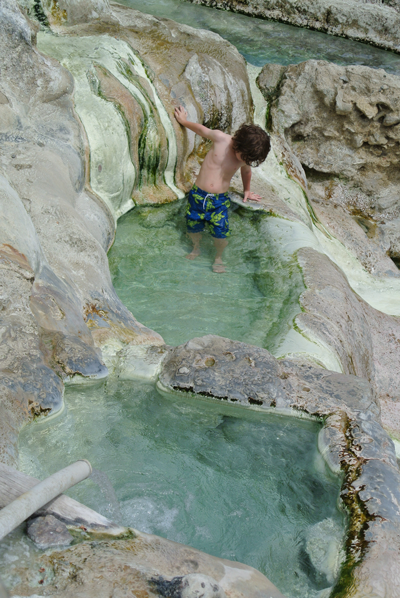Aerial view of the hot springs and the River Farma
The pools are the warmest
Our "terme" adventures brought us to these gorgeous, historic baths on the Farma river south of Sienna. Admission is free and parking is along the road. Watch your stuff since there are lots of local "pirates" and the smell is pungent, but otherwise it is a wonderful day-trip!
Petriolo has been famous since the times of the Etruscans and Romans for its natural hot sulfur springs with healing properties. In 1266 the Signoria of Siena built baths here, and the oldest spa building from the Middle Ages is still visible on one side of the bridge that crosses the river Farma. The remains of the ancient baths, consisting originally of a porch with vaulted ceilings and three square swimming pools square that once received the 'thermal water, are still visible.
There are also remnants of a city wall, built between 1404 and 1419, to protect the baths and residents from invasions, and a small church. In 1300, the famous physician Gentile da Foligno spoke of Petriolo in his "Tractatus de Balneis", recommending the use of sulfur baths to those who were suffering from respiratory diseases and overcome by joint pain.
In the fourteenth century the scholar Simon Round of Siena described Petriolo in his account of Siena, and in the fifteenth century another famous doctor Ugolino da Montecatini, in his treatise on balneotherapy "De balneorum Italiae proprietatibus ac virtutibus," said that the waters of Petriolo "very hot, dry up, dwindle and resolve the humours."
During the 14th Century, Petriolo was very well equipped with hospices, hospitals, inns and homes of rich families of Siena and Florence. Among the most frequent visitors were the Medici, and Gonzaga dukes and cardinals. Pope Pius II used Petriolo for its healing waters, as evidenced by a marble plaque affixed to one side of the ancient spa building.
Source: http://www.termedipetriolo.it/index.php?la-storia-delle-terme-di-petriolo



